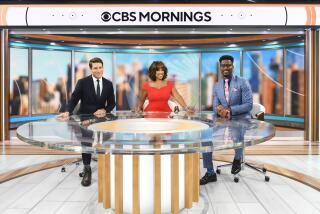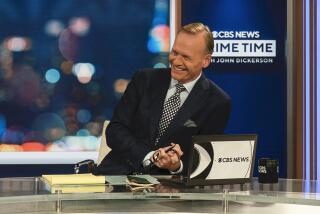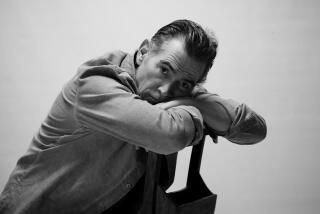‘MORNING’ AT CBS: HOLD THE TOASTS
- Share via
NEW YORK — The other morning, at an hour I regarded as more suitable for going to bed than for being up and about, I took a cab across the cold-quieted streets of Manhattan to sit in the audience of the new CBS “The Morning Program.”
The question at hand was whether the show in the flesh was as disappointing (to choose the kindest word) as most of the reviews had said it was.
Mariette Hartley, who had moved her family East to be the show’s co-host, has always seemed to me one of that small, select group of film and television actresses--beautiful, intelligent and professional--who do consistently fine work year after year without catching that one knockout role that lifts them to superstar status.
She once starred in a film about payola in the music business that was made by the late singer Bobby Darin but never released. I saw it at a private screening, one of the handful who ever did. She was first-rate as always, as she was in the docu-drama “MADD--Mothers Against Drunk Drivers”--for which she was honored.
The producer of “The Morning Program,” Bob Shanks, is an industry veteran who had a hand in ABC’s “Good Morning America” and in the “Tonight Show” and has written two much admired books about television. The first, “The Cool Fire: How to Make It in Television” (Vintage, 1977), remains an authoritative introduction to the medium.
The studio audience, treated to coffee, sweet rolls and a grateful thaw in the lobby, trooped into the bleachers 45 minutes before showtime, greeted by Bob Saget, who is the show’s third co-host, after Hartley and Rolland Smith, a handsome veteran anchorman. Amiable weatherman Mark McEwen completes the quartet.
The set provides a lot to look at. It is in an updated New England farmhouse style, all paneling and pewter, with a spinning wheel and a working gas fireplace, the whole place knickknacked by a relentless decorator.
Waiting for the show to start, I remembered the days, 35 years ago, when “The Today Show” brought live morning television to a startled nation. It was first telecast from a street-level studio in the RCA Building in midtown, and you could stop on your way to work and gaze through the windows at Dave Garroway and his trusty chimp companion, J. Fred Muggs, at work.
The essential mixture, then as now, was news, weather, interviews and the congeniality of the hosts and other on-camera types. The pressures today of time and the three-network competition (four if you count Cable News Network, as you have to) are intense beyond anything even Garroway and Sylvester (Pat) Weaver of NBC, who conceived “The Today Show,” might have expected.
What comes clear, watching “The Morning Program” unfold, is that the essential mixture is understood to be by itself insufficient to the challenge, and that there have to be some shaping presumptions, a point of attack that makes Brand C different in its appeal from Brand A and Brand N.
But what is not clear is how different a morning show can afford to be and still preserve the franchise, so to speak. The aim of “The Morning Program,” evidently, is to be softer than “The Today Show” and “Good Morning America”--easier said than done.
Starting at 7:30, “The Morning Program” follows a full hour of CBS news, which may be thought to have slaked the audience’s thirst for hard stuff. The peril is that the later start also gives both “The Today Show” and “Good Morning America” a half-hour’s lead on seizing the affections of the audience.
The show this morning is a curious mix indeed. There is an interview with a Connecticut housewife whose son was accused of spray-painting a house on Halloween--he denied it, she believed him and fought the case, and he was vindicated. A warm little segment, but overlong and with almost nothing heard from the boy himself.
George Kirgo is seen contributing some reviews from the West Coast, taped in an unimaginative limbo, promoting a TV special he acknowledges he hasn’t seen, being amusing about “Outrageous Fortune.” OK, but oddly detached and uninvolved with the show as a whole.
Another regular taped feature, introducing new comics, this day features a black comedienne doing jokes based on racial stereotypes that would evoke winces after midnight and must have played peculiarly over the corn flakes in Indiana.
Anne Meara arrives to promote a CBS afternoon special in which she plays a librarian fighting attempts to remove classic works from her shelves. An important subject and Meara has done her homework, but Hartley’s notes appear to be muddled, and the talk shifts quickly to Meara’s other activities.
There is a fashion show of very expensive designer outfits for children, including one $400 outfit. Attractive kids, but a piece of material that cries for some indication that somebody had his or her tongue in cheek.
The piece de resistance is the introduction of the five most eligible bachelor women in the universe (or some other geographical space) as chosen by Gentlemen’s Quarterly. It is obvious that they are all achievers, but what they have achieved nobody bothers to ask, or say.
Anchorman Smith, who appears to be permanently cast as a throwback male chauvinist, whatever his private sensibilities, asks some questions about the men these women might be persuaded to marry. He receives some refreshingly witty answers. One woman replies that she would settle for Mr. OK instead of Mr. Right, as long he is a Democrat.
But the possibility of extracting some interest from what was on the face of it a gimmicky confection goes abegging. Reportage does not appear to be, or is not encouraged to be, Smith’s bag.
The brightest bit on the show is Bob Saget’s interview with a polar bear, played by Tony Hendra, a National Lampoon alumnus who is one of the show’s writers. From beneath the mask, Hendra complains hollowly that TV is anti-bear, and points out that even Grizzly Adams is not a real bear. It was sharp and charming foolishness.
It may be that it’s too late to compete with “The Today Show” on its own well-evolved terms. And it could be that there is a loyal audience for the kind of soft and non-confrontational programming “The Morning Program” is trying for. What occurred to me is that the spiritual ancestor of the CBS show is not its NBC rival, but Don McNeil’s “Breakfast Club,” from radio days.
Yet I have to believe that “The Today Show” prospers because it seldom patronizes its viewers. Taking Hartley and Smith off half-throttle and allowing them to ask good questions now and again would be part of the lift the presently under-compelling “Morning Program” needs.
More to Read
The complete guide to home viewing
Get Screen Gab for everything about the TV shows and streaming movies everyone’s talking about.
You may occasionally receive promotional content from the Los Angeles Times.






